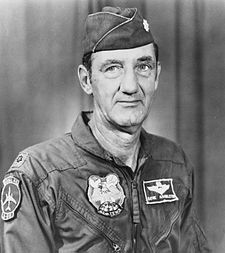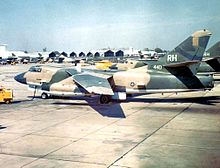This article's tone or style may not reflect the encyclopedic tone used on Wikipedia. (January 2024) |

The rescue of Bat 21 Bravo, the call sign for Iceal "Gene" Hambleton (a navigator aboard an EB-66 aircraft shot down behind North Vietnamese lines), was the "largest, longest, and most complex search-and-rescue" operation during the Vietnam War.[1][2] Five additional aircraft were shot down during rescue attempts, directly resulting in the deaths of 11 airmen, the capture of two others, and another airman trying to evade capture.
On 2 April 1972, the Easter Offensive, the largest combined arms operation of the entire Vietnam War, was in its third day. An early morning flight of two United States Air Force EB-66 aircraft was led by Bat 20. Hambleton was a navigator aboard Bat 21. The two aircraft were escorting a cell of three B-52s. Bat 21 was configured to gather signals intelligence, including identifying North Vietnamese anti-aircraft radar installations to enable jamming. Bat 21 was destroyed by an SA-2 surface-to-air missile (SAM) and Hambleton was the only survivor, parachuting behind the front lines into a battlefield filled with thousands of People's Army of Vietnam (PAVN) soldiers.

Hambleton had Top Secret access to Strategic Air Command operations and was an expert in SAM countermeasures. The PAVN may have possessed information about his presence in Vietnam and his capture would have meant a huge intelligence bonanza for the Soviet Union.
Hambleton and 1st Lt. Mark Clark, who was shot down during rescue operations, were recovered from behind the front lines on two different nights in covert, night-time rescues carried out by U.S. Navy SEAL Thomas R. Norris and Republic of Vietnam Navy (RVNN) commandos. For their actions in rescuing the two men, Norris was awarded the Medal of Honor and RVNN Petty Officer Nguyễn Văn Kiệt was recognized with the Navy Cross. Nguyen was the only South Vietnamese sailor given that award during the war.
The Air Force did not put limits on what it took to rescue a downed airman. The direct and indirect cost of rescuing Hambleton was enormous and became a watershed event in Air Force search and rescue. To prevent friendly fire incidents, the Americans imposed a standard no-fire zone within a 27 kilometers (17 mi) radius of Hambleton and diverted aircraft to aid in his rescue. In addition to the direct casualties caused by the rescue mission, it is likely that South Vietnamese soldiers indirectly died as a result of their inability to obtain fire support.[3]: 120
The added deaths, loss of aircraft, and length of the rescue operation led the USAF to change the way they planned and conducted search and rescue missions. As a result, they developed new techniques and equipment to improve their ability to rescue downed airmen.
- ^ Zimmerman, Dwight Jon; Gresham, John D. (2008). Beyond Hell and Back: How America's Special Operations Forces Became the World's Greatest Fighting Unit. St. Martin's Press. p. 320. ISBN 978-0-312-38467-8. Archived from the original on November 16, 2017.
- ^ Busboom, Lt. Col. Stanley (April 2, 1990). Bat 21: A Case Study. Carlisle Barracks, PA: U.S. Army War College. Archived from the original on March 20, 2012. Retrieved April 3, 2011.
- ^ Cite error: The named reference
tilfordwas invoked but never defined (see the help page).